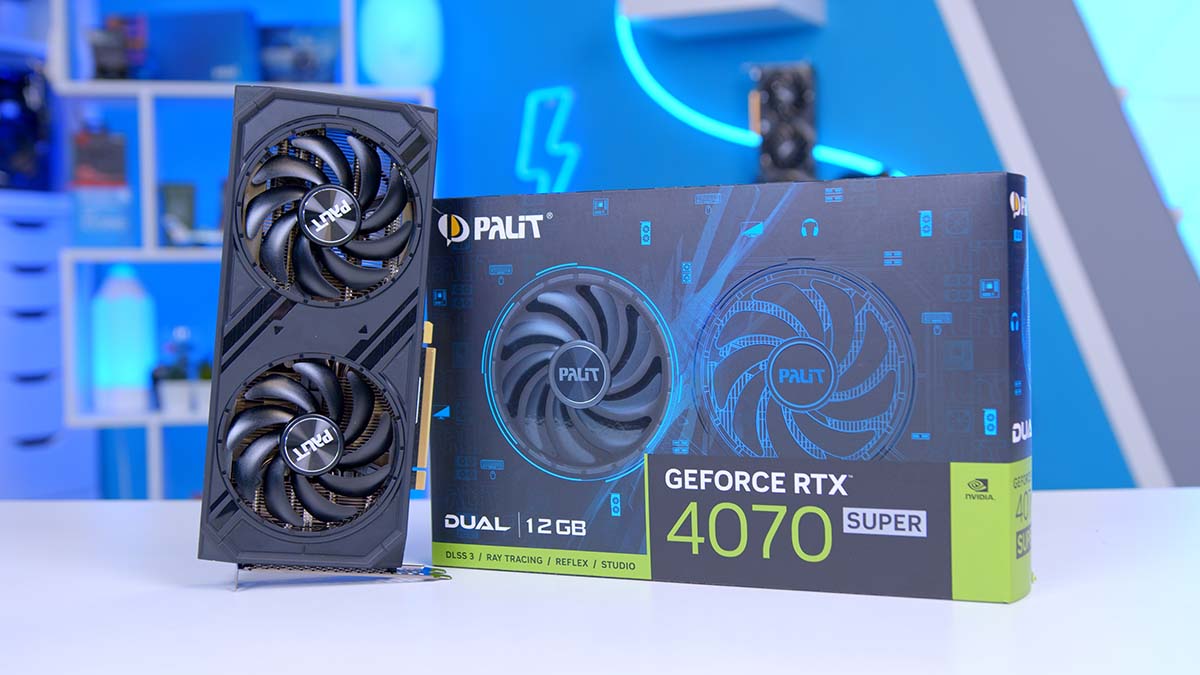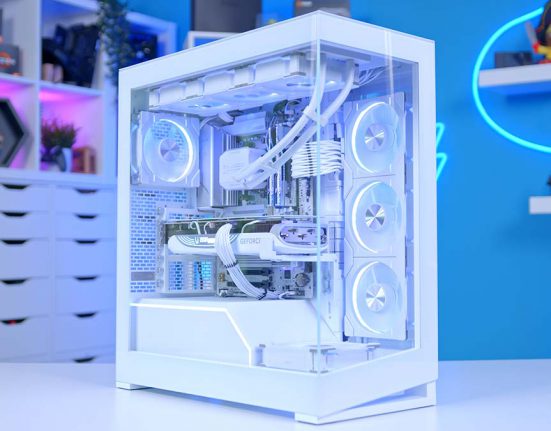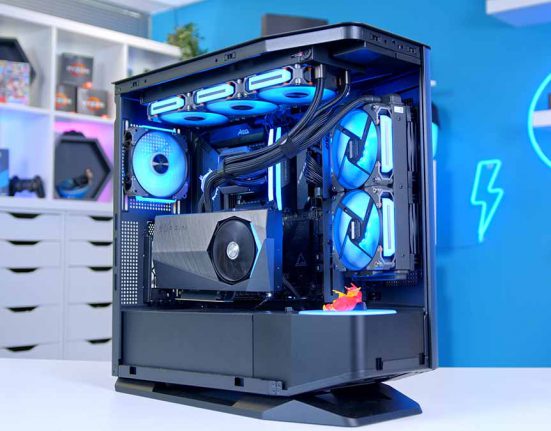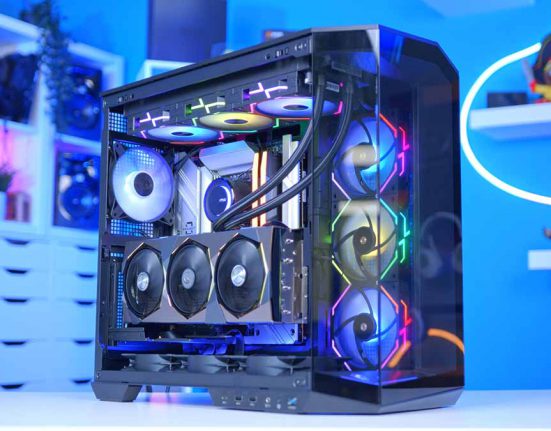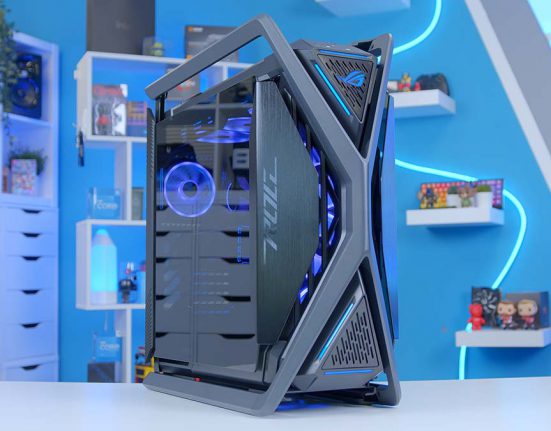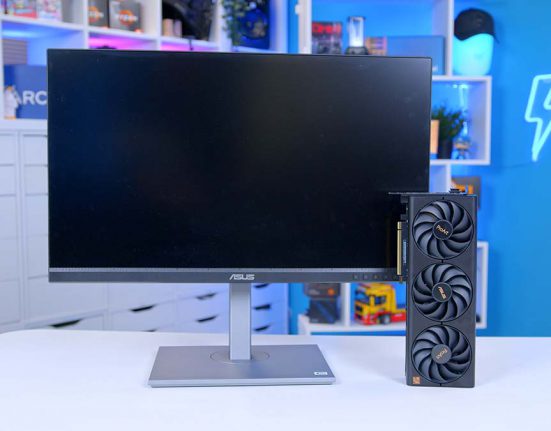The 1440p gaming market is constantly shifting, with manufacturers looking to become the go-to option with new graphics cards constantly being pumped out year on year. It is fairly obvious that 1440p gaming is a market that NVIDIA are keen to hit with their release of the RTX 4000 SUPER range of cards. Competing with AMD’s top dog, the RX 7800 XT, the RTX 4070 SUPER is a revitalised version of the vanilla RTX 4070 with improved hardware, and better performance.
The RTX 4070 Ti SUPER and RTX 4080 SUPER will be launching alongside the RTX 4070 SUPER, as high-end options. NVIDIA’s Ada Lovelace architecture (which is what the RTX 4000 range uses) has been extremely impressive, so we fully understand why NVIDIA are looking to bring the competition to AMD with some mid-life refreshes.
In today’s review, we’ll be taking a look at the Palit Dual variant of the RTX 4070 SUPER. We’ll be evaluating the performance with a myriad of different gaming benchmarks, while also analysing the value proposition that this card offers in comparison to the rest of the market.
Buy the Palit RTX 4070 SUPER Dual on:
Specifications
The main improvements of the RTX 4070 SUPER range worth noting are the increased core counts and clock speed capability. When compared to the original RTX 4070, we’re seeing a 21% rise in CUDA cores with 7168 on offer, as opposed to the 5888 that came with the RTX 4070. RT Cores and Tensor cores have also been given a slight increase from 46 to 56, and 184 to 224 respectively. Power draw has also risen slightly, with a max output of 220W in comparison to the 200W TDP of the RTX 4070.
| Specification | Palit RTX 4070 SUPER Dual |
|---|---|
| Video Memory | 12GB GDDR6X |
| Memory Bus | 192-bit |
| Core Clock Speed | 1.98GHz |
| Boost Clock Speed | 2.47GHz |
| CUDA Cores | 7168 |
| RT Cores | 56 |
| Tensor Cores | 224 |
| Power Consumption | 220W |
| MSRP | $599 |
The rest of the specs remain unchanged, but boost clock speeds will differ dependent on the variant of card that you’ve chosen. While Gigabyte’s WINDFORCE OC variant offers a slight increase to 2.49GHz, the Palit Dual option that we’re taking a look at today sports the same clock speed as the Founders Edition option.
VRAM will be a concern for some, as the RTX 4070 SUPER only offers 12GB. Compared to the RX 7800 XT which has 16GB of VRAM to spare, this is a factor worth considering if you play a lot of games that use high amounts of VRAM. However, we found 12GB to be ample across our benchmarks.
| Spec | RTX 4070 | RTX 4070 SUPER | RTX 4080 |
|---|---|---|---|
| Video Memory | 12GB GDDR6X | 12GB GDDR6X | 16GB GDDR6X |
| Memory Bus | 192-bit | 192-bit | 256-Bit |
| Core Clock Speed | 1.92GHz | 1.98GHz | 2.21GHz |
| Boost Clock Speed | 2.47GHz | 2.48GHz | 2.51GHz |
| CUDA Cores | 5888 | 7168 | 9728 |
| Tensor Cores | 184 | 224 | 304 |
| RT Cores | 46 | 56 | 76 |
| Power Consumption | 200W | 220W | 320W |
| MSRP | $549 | $599 | $1199 |
What is RTX SUPER?
NVIDIA’s RTX SUPER range of cards was initially introduced back in 2019 after the original RTX 2000 range. These refreshed RTX 2000 options improved some of the specs, and rebranded the cards to ‘SUPER’ variants. Three cards saw a performance boost with improvements to the core counts, while the RTX 2060 SUPER received a VRAM increase.
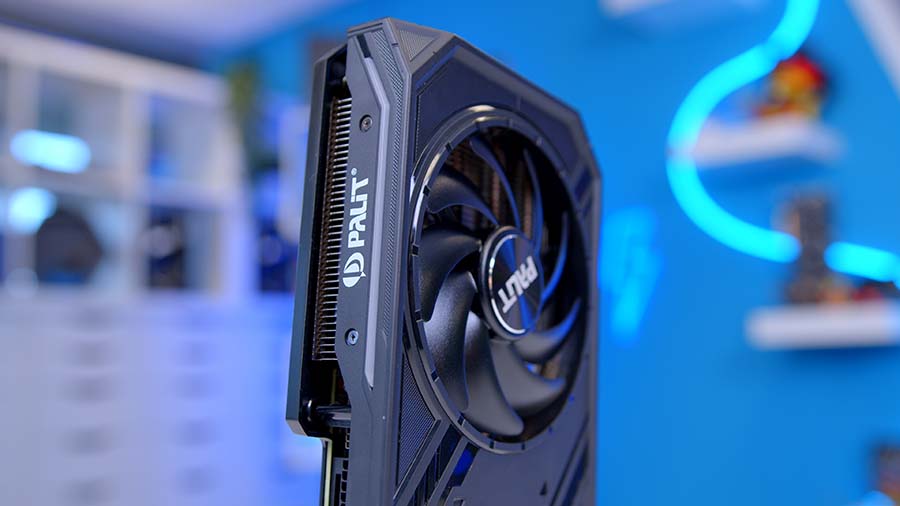
While NVIDIA has employed a similar approach to the RTX 4000 range, there’s more of a focus on the mid-range and high-end sides of the market. The RTX 4070, RTX 4070 Ti, and RTX 4080 are the three cards to receive a refresh. There are whispers of lower-end cards, such as the RTX 4060 being revitalised, but there’s no official announcement as of yet.
The most exciting element of the RTX 4000 SUPER range is an adjusted set of prices, which also includes a price drop of the existing RTX 4070. NVIDIA were under fire during a number of the RTX 4000 launches due to staggeringly high prices, so we’re not surprised that there’s a plan to recoup favour among buyers.
| Model Name | MSRP |
|---|---|
| RTX 4060 | $299 |
| RTX 4060 Ti 8GB | $399 |
| RTX 4060 Ti 16GB | $499 |
| RTX 4070 | $549 |
| RTX 4070 SUPER | $599 |
| RTX 4070 Ti | $799 |
| RTX 4070 Ti SUPER | $799 |
| RTX 4080 | $1199 |
| RTX 4080 SUPER | $999 |
| RTX 4090 | $1599 |
Taking a look at the specifics, the RTX 4070 SUPER remains at $599, while offering a 15%-20% performance boost compared to the original RTX 4070, making it a great competitor within the mid-range space.
The RTX 4080 SUPER has received a price drop down to $999, which means it is a likely contender to dethrone the RX 7900 XTX. The RTX 4070 Ti SUPER does sit at $799, but because this card has seen a 4GB increase in VRAM, there’s an element of cost recovery going on here.
Design
We’ve done a deep dive on the Best RTX 4070 SUPER Graphics Cards in a dedicated roundup, highlighting the key differences between them. However, our focus of this review is the Palit Dual variant, which is an MSRP dual-fan option. Sitting at 269mm in terms of length, the Palit RTX 4070 SUPER Dual is one of the smaller cards we’ve looked at. This particular GPU will be ideal for a compact build, as the total length shouldn’t cause any clearance issues, even within most modern ITX cases.
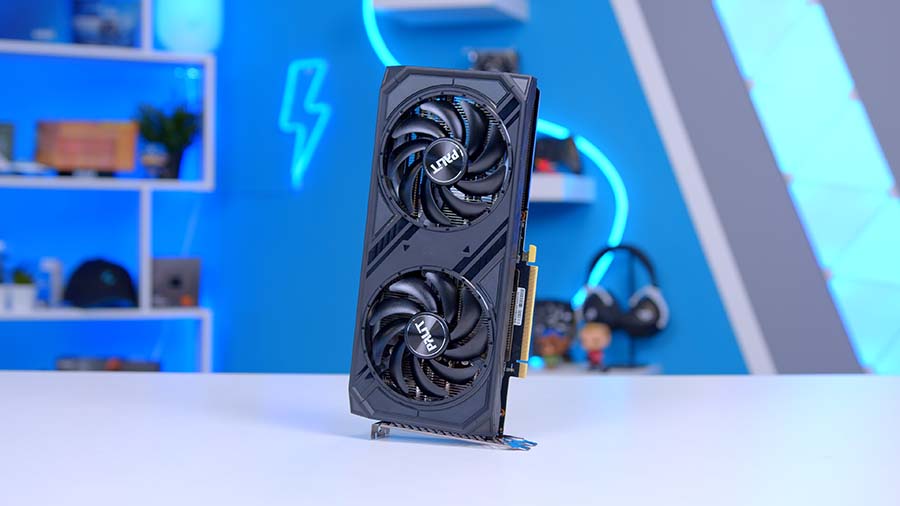
On the aesthetic front, the Palit RTX 4070 SUPER Dual sports an all-black shroud, followed by two black fans with the Palit logo at the centre of them. Ultimately, this card is rather simplistic in its look. While it will blend in well with other dark components, it offers a minimalist aesthetic that will appeal to some, but not everyone. The two most interesting areas to note about this card, is the top, and the backplate.
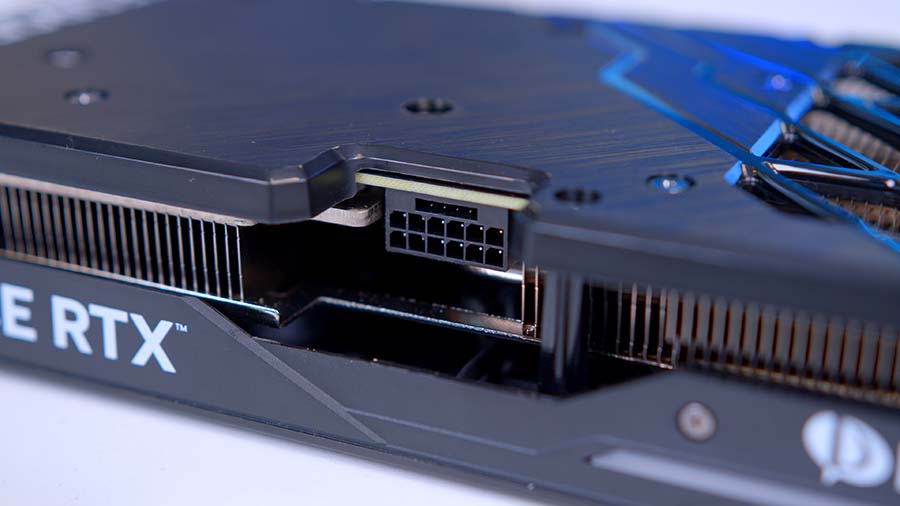
Towards the top right of the Palit Dual, you’ll find an RGB strip. If you’ve decided to mount your graphics card traditionally (i.e. without a vertical riser), the RGB strip will be easily visible, adding some flair to your PC build. With Palit’s ThunderMaster software you’ll be able to customise the RGB lighting effects, with controls for overclocking and GPU stats.

The backplate of the Palit RTX 4070 SUPER Dual offers a cutout towards the left of the card making your heatsink fins visible through the shrouding. This should ease temperatures to a degree, making heat dissipation more efficient. Because the Palit Dual model only offers two fans, the lack of a third will be noticeable in tougher workloads, so its great that Palit are alleviating this with some passive cooling and better airflow.
Overall, I think the aesthetic that the Palit Dual variant of the RTX 4070 SUPER offers is fine. It won’t blow you away, but the consistent colouring across the shrouding of the card is very well done, making a dark-themed build very possible. The RGB lighting bar on the top of the card is a nice touch too if you’re looking for some customisation options.
Performance
To determine what kind of performance is on offer from the Palit RTX 4070 SUPER Dual, our benchmarker Harry Coleman has put all of our RTX 4070 SUPER variants through the wringer within a range of popular Esports games and triple A titles. Our testing in this review focuses on the main differences in performance between each model, instead of a comparison against the rest of the market. Despite this, we’ve created a table below that highlights some worthy alternative graphics cards that are worth checking out.
For a full rundown of performance versus cards like the RX 7800 XT, or the RTX 4070 Ti, we recommend checking out our Founders Edition review of the RTX 4070 SUPER.
| GPU Name | Availability |
|---|---|
| AMD Radeon RX 7700 XT | $449 |
| AMD Radeon RX 7800 XT | $499 |
| NVIDIA RTX 4070 | $549 |
| NVIDIA RTX 4070 SUPER | $599 |
| NVIDIA RTX 4070 Ti | $799 |
| NVIDIA RTX 4070 Ti SUPER | $799 |
Cyberpunk 2077
Settings: 1440p, Shadow Quality High, Indirect Lighting High, Reflections High, Crowd Density High, Particle Quality High, Volumetric Lighting High, Motion Blur off, GTAO Quality High, Grass Quality High, Contact Shadows High VSync Off, DLSS: On/Off, Ray Tracing: On/Off, Textures: High
In Cyberpunk 2077 we ran two different benchmarks, one with ray tracing and DLSS, and one with these settings turned off. In our rasterized gameplay benchmark, the Palit RTX 4070 SUPER Dual sits towards the top of the graph, offering a 104FPS average in comparison to the rest of the options we’ve tested. Results are very tightly knit here, but performance was still impressive nonetheless.
When we switched on ray tracing and DLSS, framerates did drop by a small margin. Palit’s RTX 4070 SUPER Dual offered up 88FPS on average, which is the same performance that the Founders card sits at. Again, framerates were very close overall, which does show that performance is almost negligible across different variants.
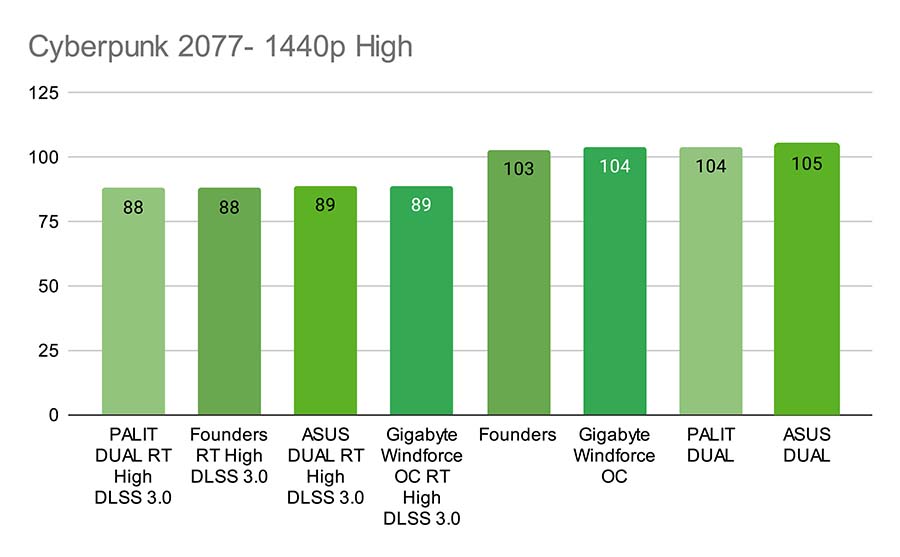
Alan Wake II
Settings: 1440p, Post-Processing High, Texture Resolution High, Texture Filtering High, Volumetric Lighting High, Global Illumination Quality High, Shadow Detail High, Terrain Quality High, Ray-Tracing: Enabled, Ray Tracing Preset High, DLSS: Enabled, Frame Generation: On
In Alan Wake II, we ran a similar set of benchmarks with ray tracing and DLSS both on and off, which yielded different results. In our ray tracing benchmark, the Palit Dual variant was able to offer around 94FPS on average, putting it at the bottom of the GPUs we’ve tested. There’s only 3 frames between the Palit Dual and ASUS Dual variant, but in an intense game like Alan Wake 2, frames do matter.
Once we switched off DLSS and ray tracing, rasterized performance dropped below the 70FPS mark for the Palit RTX 4070 SUPER Dual. We saw a 69FPS average, which is getting close to choppy gameplay. This might be down to optimisation issues, but it is disappointing that the RTX 4070 SUPER does struggle when it comes to pure raw performance.
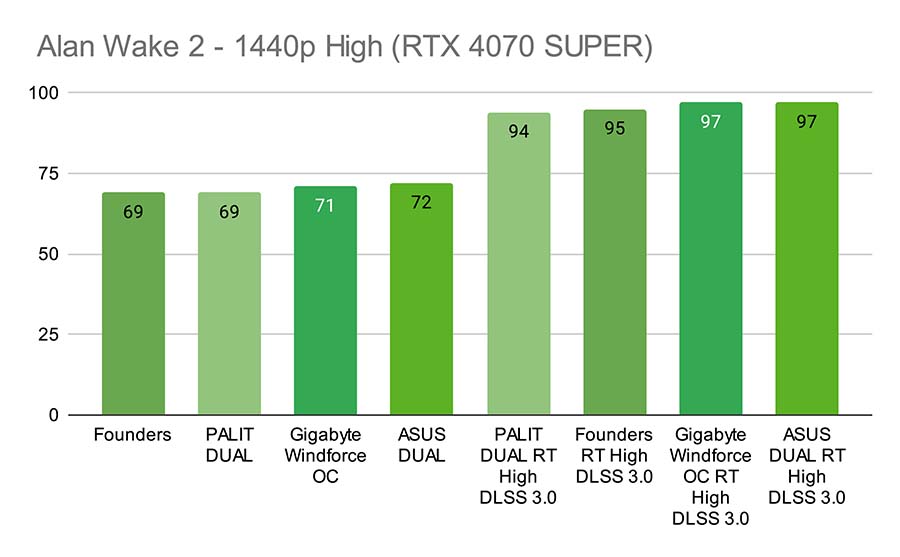
COD Warzone
Settings: 1440p, DLSS: On/Off, Texture Resolution High, Texture Filter Anisotropic High, Level of Detail High
In COD Warzone we saw a dramatic increase in framerates, surging up to the 140FPS mark in our rasterized benchmark. The Palit RTX 4070 SUPER Dual was the weakest of the four cards that we tested but still very capable overall. Dumbing down some more settings will allow you to surpass the 144Hz mark, which will be ideal for this fast-paced FPS title.
When DLSS 3.0 was switched on, the Palit Dual variant was able to output around 196FPS, which is a 56FPS rise! The boost in framerates is mostly down to DLSS here, but this technology will be worth it for many looking to maximise their frames.

F1 2022
Settings: 1440p, Ray Tracing: On/Off, Lighting Quality Ultra High, Post Process High, Shadows Ultra High, Weather Effects Ultra High, Ambient Occlusion HBAO+, Asynchronous Compute On, Texture Streaming Ultra High, Anisotropic Filtering 8x, DLSS: On/Off
Our final head to head benchmark was F1 2022, where we did two separate runs with ray tracing and DLSS enabled, and one without these settings. Rasterized performance was strong across all of the cards that we tested. Palit’s Dual variant of the RTX 4070 SUPER was one of the best performing options within this benchmark, offering an average framerate of 227FPS.
With ray tracing and DLSS enabled, the Palit RTX 4070 SUPER Dual was able to output 187FPS, which is very strong considering how intense this game can be at times. Despite being slightly weaker than the other variants when ray tracing is enabled, the Palit Dual variant was still able to provide a strong showing.
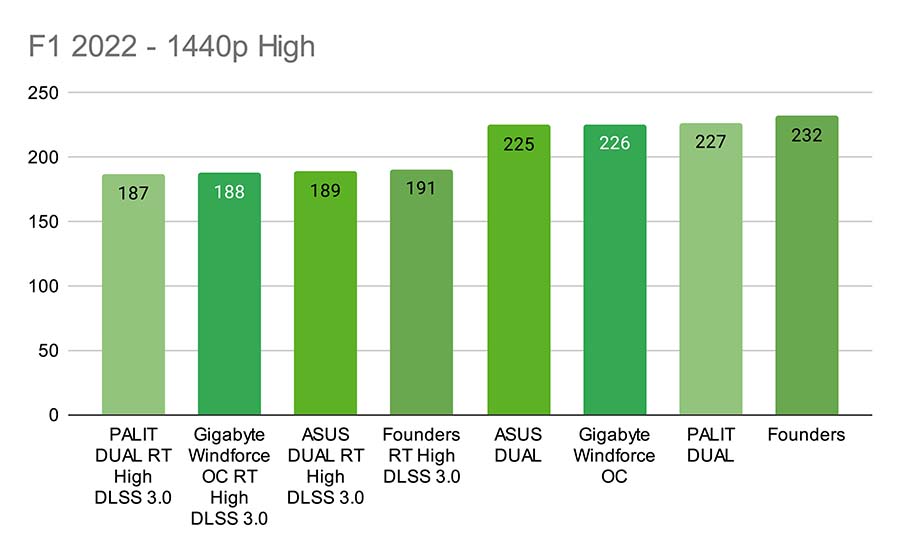
Cost Per Frame
Raw performance is an important metric that we use to assess the value proposition of a graphics card. However, cost per frame is another useful way to see how many frames you’re paying for based on the MSRP of your card. The graphs we’ve provided below assess the framerate average within Apex Legends and Hogwarts Legacy, allowing us to ascertain the cost per frame at 1440p.
Apex Legends
In Apex Legends, we saw a cost per frame for the RTX 4070 SUPER of $2.55. This aligns it with the RX 7700 XT which is a worthwhile card to consider, but doesn’t quite match up to the performance of the RTX 4070 SUPER despite its lower framerate. NVIDIA are definitely getting more competitive here, with three of their cards sitting at the mid-range point of the graph. The RTX 4070 SUPER is definitely a solid 1440p card when we’re considering cost per frame.
The RTX 4070 SUPER isn’t unfortunately able to beat our the RX 7800 XT, where VRAM and a lower price point are the big wins for this AMD card.

Hogwarts Legacy
In Hogwarts Legacy, the data does shift slightly due to the diminished performance within this title. Hogwarts Legacy is much more intense in comparison to Apex Legends, hence the RTX 4070 SUPER sitting at 5.76 when it comes to cost per frame. The RTX 4070 SUPER is definitely looking like a worthy upgrade when compared to other 1440p capable options, but the RX 7800 XT and RX 7700 XT are still coming in at a better price point.
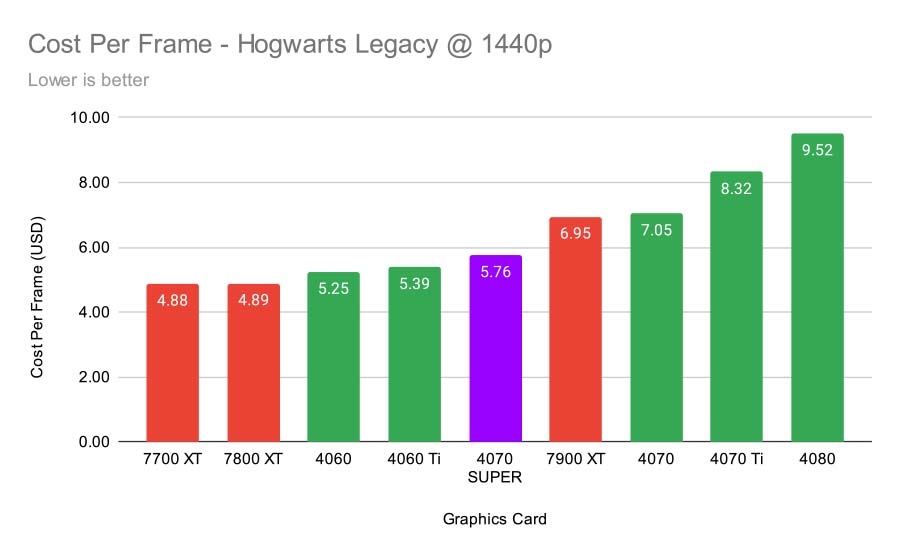
Is RTX 5000 Worth Holding Out For?
Addressing future GPU launches isn’t something we normally do, unless we’ve got some confirmed rumours or data. However, with mid-life refreshes hitting the market, it makes sense to briefly address the potential RTX 5000 range. The prospect of a new generation of graphics cards is always exciting, and one that many buyers will consider when picking out an upgrade. Rumours indicate that NVIDIA’s RTX 5000 range is codenamed ‘Blackwell’ slated to launch towards Q4 of 2024, or in Q1 of 2025.
We’re not in any position to make any guesses on the performance, but based on the pattern of recently released options from AMD and NVIDIA, we’re unlikely to see a market where the RTX 500 range dominates over the existing RTX 4000 set of cards. And with games becoming extremely demanding over the past couple of years, we’re not seeing the extremely impressive metrics that we’ve been used to with RTX 3000 and before. But despite this, the current landscape of graphics cards is highly competitive, making now a perfect time to pick up a brand new GPU.
Palit RTX 4070 SUPER Dual
Product Name: RTX 4070 SUPER
Brand: Palit
-
Features
-
Design
-
Performance
-
Value For Money
Summary
Palit’s RTX 4070 SUPER Dual is a solid graphics card geared towards price conscious buyers looking to pick up an RTX 4070 SUPER. This dual-fan design offers reasonable thermals, provides some customisable RGB lighting, and comes in at MSRP. While this card is weaker on the performance front compared to the other variants that we’ve tested, the performance difference is effectively negligible, with only a few frames between each card.
We found that the Palit RTX 4070 SUPER Dual held up very well in both rasterized and ray traced gameplay, providing smooth visuals and solid metrics across a range of titles. We feel that the only thing going against this Palit option is the alternative MSRP cards available on the market. Both the ASUS Dual and Gigabyte WINDFORCE OC variants held up very well in our testing, providing better thermals and stronger performance. Gigabyte’s WINDFORCE model is especially tantalising based on the fact that this is a triple-fan MSRP GPU. But despite this, the Palit RTX 4070 SUPER Dual is still a great MSRP card, ideal for those looking to pick up a high performance 1440p GPU.
Pros
✅ Gaming performance
✅ Smaller size
✅ Customisable RGB
Cons
❌ Minimalist design
❌ A weaker variant
❌ Dual-fan design


